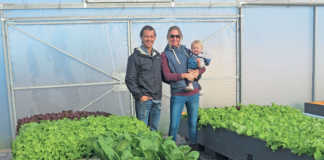But even though different crops have to be fertilised differently to achieve specific objectives, one still has to take into account what’s already in the soil. Cabbages are too expensive to grow without a soil analysis as a basic guide. If you apply too much of one element, you’ll disturb the soil’s balance and in the end waste money.
The plant takes up certain groups of fertiliser elements available in the soil, and not necessarily in the correct proportion for best plant growth. The plant can’t select each element according to its requirements from the soil solution, just as you can’t take the sugar out of your tea if someone puts too much in it. The soil test is therefore a small price to pay, considering the benefits of fertiliser savings and better crop performance.
Plants in poor conditions
Plants have two main objectives: survival and reproduction. The plant will regulate and adjust its growth and cell structure to cope with strenuous conditions, such as cold, heat, drought and fertility problems. These adjustments are there to help the plant survive difficult conditions, but it sacrifices performance in the process. To prevent the plant from having to sacrifice its performance, firstly balance the soil with the correct ingredients. Only once that is done, can you look into the requirements for your specific crop.
You will need to apply nitrogen to regulate the cabbages’ growth. Seedlings need sufficient nitrogen in the seedling plug and in the seedling itself for a fast start.When transplanting seedlings, you have to provide frequent light irrigation to keep the plant’s roots, which are still in the growing medium, alive. Once the roots get into the soil, the situation changes, as the plant taps into the soil moisture and nutrients. The tempo of irrigation now changes. The nitrogen in the seedling helps provide the energy for more rapid root growth, which shortens the hazardous period of establishing the plant.
The benefits of getting it right
There are two main benefits to this process. The first is uniformity of stand. If everything is favourable for the plants, they’ll grow at maximum rate from the start without some plants being favoured more than their siblings. A uniform stand will make management easier right up to harvesting and provide a higher yield. Secondly, the plant will produce larger leaves, enabling it to produce larger heads. If you haven’t provided good conditions, you may lose plants or develop runts. If you lose 5% of your plants, you might not see the difference a month later, but it will reflect in the yield.
Speaking from own experiences
When I started farming, and would slip up with my management and get into this position, my boss would drive by the land when it was growing well and remark on how good the crop was looking. Only I knew of the problem, which I wasn’t going to share with him! The evidence of my neglect was well hidden, but when it came to harvest, the difference was clear in the relative lower tonnage harvested. All too often one rushes planting and establishing the crop, but it’s a vital part of our crop production and warrants more attention than it generally gets.
Bill Kerr (016 366 0616 or e-mail [email protected]).













